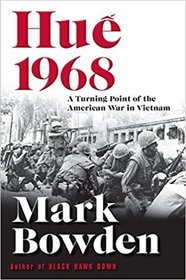One of my favorite photographs of myself while I was in the Marines shows me leaning against a stone wall in Hue wearing my combat gear and a poncho, as it was pouring rain. This wasn't in 1969, but a few years later. I was running a convoy from Da Nang to Quang Tri in early 1971.
Hue is famous in the Marines for the Corps' efforts there. But it wasn't until i read this book that I realized just how desperate the Marine action was with most of the upper brass (Army and Marines) thinking this was just a small unit action that a couple of companies could take care of. If they had understood what was really happening in Hue, more troops would have been committed sooner and the battle would have been much shorter.
When reading the book you get the impression that thousands of U.S. and South Vietnamese service personnel were killed. But in the last chapter the author lists 250 U.S. Marines and Army killed and 1,554 wounded. About 458 ARVN soldiers were killed and an estimated 2,700 wounded. The VC and NVA killed and wounded counts are between 2,400 and 5,000. As with any armed conflict in a city, the poor civilians took the most terrible losses. Thousands of civilians were killed from fire by both sides, and the number of wounded is unknown. Plus their historic city was essentially destroyed.
Over and over the author makes the point that General Westmoreland had a self-deluded fantasy about what was happening in the Tet offensive. And he was right. It's a terrible thing when our generals and admirals think more about politics than about fighting a war, and continue to support their own beliefs instead of what their intelligence people are saying. As a result, after Tet Westmoreland was "promoted" to a higher level so he could be replaced by someone who knew what was going on.
Two interesting aspects of the book: Early on the author casually mentions a USMC friend of mine, as "Lieutenant Steve Lampo." I first met Lampo when he was a major and I was a captain in 3rd Battalion, 24th Marines, a USMC Reserve infantry unit in St. Louis. I liked and respected him then, and still fondly remember him. Sadly he died in an automobile accident later on. I never knew he was in Hue during the Tet offensive, but Lampo was never a braggart. The second and very unusual aspect of the book is while the author has a lot of notes supporting his text, there is no index for this history book. This really surprised me.
Although often discussing higher level reactions to the fighting in Hue, as high as President Johnson, the author really concentrates on the company level and below to the individual fighting men and women. He had access to many of the veterans on both sides and relates their stories, often following individuals from before the battle to their activities in 2017, when the book was published. It is this concentration on those individuals which make this a fascinating read.
Hue is famous in the Marines for the Corps' efforts there. But it wasn't until i read this book that I realized just how desperate the Marine action was with most of the upper brass (Army and Marines) thinking this was just a small unit action that a couple of companies could take care of. If they had understood what was really happening in Hue, more troops would have been committed sooner and the battle would have been much shorter.
When reading the book you get the impression that thousands of U.S. and South Vietnamese service personnel were killed. But in the last chapter the author lists 250 U.S. Marines and Army killed and 1,554 wounded. About 458 ARVN soldiers were killed and an estimated 2,700 wounded. The VC and NVA killed and wounded counts are between 2,400 and 5,000. As with any armed conflict in a city, the poor civilians took the most terrible losses. Thousands of civilians were killed from fire by both sides, and the number of wounded is unknown. Plus their historic city was essentially destroyed.
Over and over the author makes the point that General Westmoreland had a self-deluded fantasy about what was happening in the Tet offensive. And he was right. It's a terrible thing when our generals and admirals think more about politics than about fighting a war, and continue to support their own beliefs instead of what their intelligence people are saying. As a result, after Tet Westmoreland was "promoted" to a higher level so he could be replaced by someone who knew what was going on.
Two interesting aspects of the book: Early on the author casually mentions a USMC friend of mine, as "Lieutenant Steve Lampo." I first met Lampo when he was a major and I was a captain in 3rd Battalion, 24th Marines, a USMC Reserve infantry unit in St. Louis. I liked and respected him then, and still fondly remember him. Sadly he died in an automobile accident later on. I never knew he was in Hue during the Tet offensive, but Lampo was never a braggart. The second and very unusual aspect of the book is while the author has a lot of notes supporting his text, there is no index for this history book. This really surprised me.
Although often discussing higher level reactions to the fighting in Hue, as high as President Johnson, the author really concentrates on the company level and below to the individual fighting men and women. He had access to many of the veterans on both sides and relates their stories, often following individuals from before the battle to their activities in 2017, when the book was published. It is this concentration on those individuals which make this a fascinating read.




